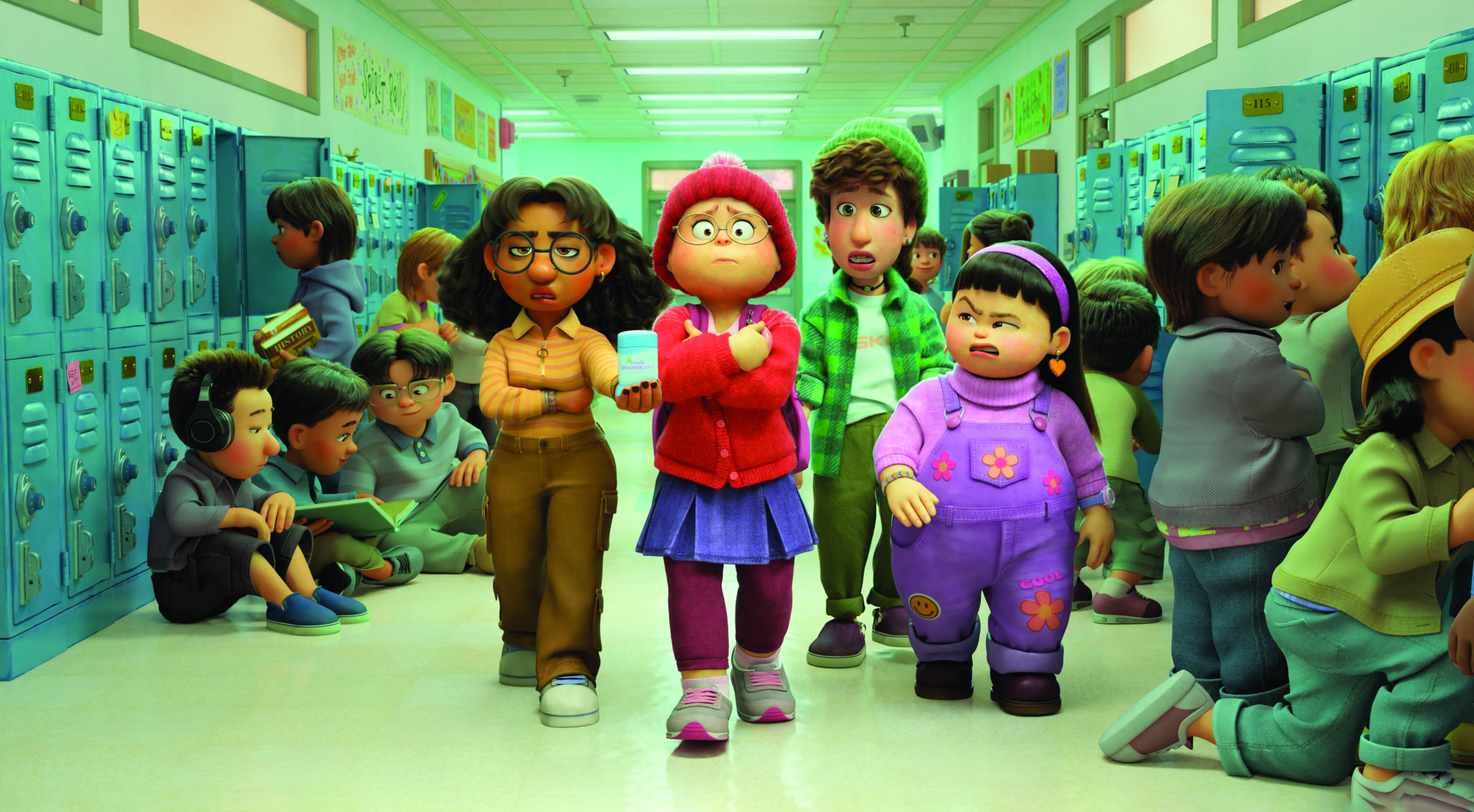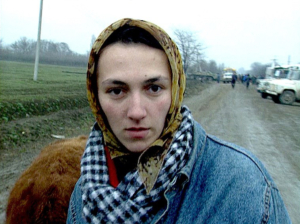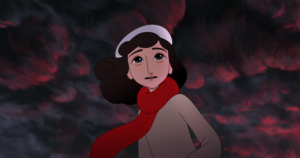Being thirteen is a chaotic, magical, confusing and downright messy time. Your body is changing. Your hormones are raging. The adults in your life urge you to be more responsible, yet still treat you like a little kid a lot of the time. Time spent with your friends can be magical or boring, dramatic or even frustrating. School is intensifying. You are evolving into a grown-up, but the eventual form of your adult self remains unknown.
Pixar animated feature Turning Red (Domee Shi, 2022) takes a look at this pivotal time in one girl’s life and puts a metaphorical spin on it. It’s 2002, and Chinese-Canadian Year 8 student Meilin (Rosalie Chiang), or ‘Mei’ to her friends and family, is living her best life – or so she tells us. Shi uses a distinctive visual style to tell this story, linking elements of Japanese animation and early 2000s aesthetics: think Tamagotchis, cute-yet-oversized anime eyes (complete with sparkles) and Sailor Moon. Shi herself has described the style as an ‘Asian tween fever dream’.[1]Domee Shi, quoted in Bill Desowitz, ‘Turning Red Is Pixar’s Next Big Thing: How Director Domee Shi Made an “Asian Tween Fever Dream”’, IndieWire, 7 February 2022, <https://www.indiewire.com/2022/02/turning-red-domee-shi-pixar-1234696033/>, accessed 23 May 2022.
Mei has a gang of great friends, loves being a smart kid and is a happily self-described nerd. In her spare time, she has a part-time job running her family’s ancestral temple with her mum, Ming (Sandra Oh). Overall, she is having a pretty good – and pretty recognisable – experience of being thirteen. Sometimes, though, Mei feels caught between what she loves to do and what her parents expect her to do.
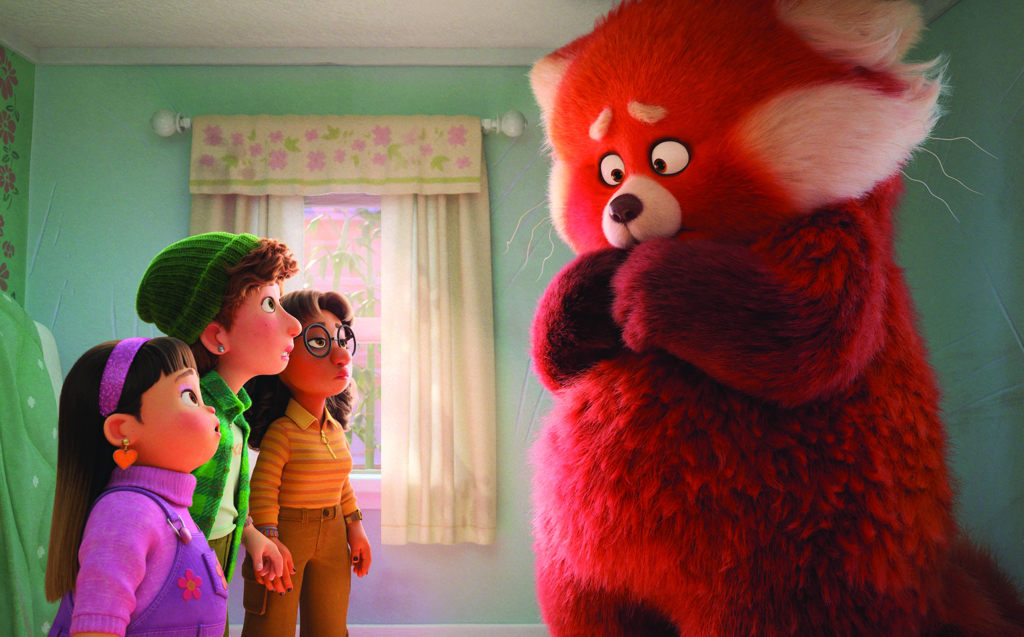
The tenor changes abruptly one day when Ming catches a glimpse of Mei’s secret notebook. In it, Mei has been secretly doodling a picture of Devon (Addie Chandler), a boy she has a crush on. The discovery throws Ming into a tizzy, transforming her into a nightmare of a helicopter mum. Grabbing her car keys with a deeply embarrassed Mei in tow, she heads to where Devon works part-time to berate him. Ming’s tirade at Devon (who isn’t even aware that Mei is interested in him) is witnessed by a bunch of kids who go to their high school, ensuring that news of Mei’s humiliation will travel far and wide.
In the car on the way home, Mei feels ashamed and angry at her mum, but, with superhuman effort, keeps her emotions tightly under control. After all, to react to Ming’s actions would be in direct contrast to her role as the ever-dutiful daughter.
• What visual motifs does the film use to foreshadow the unexpected changes that Mei is about to go through?
• Turning Red is set in 2002. If the film were set today, how do you think the major events of the past few years (such as the COVID-19 pandemic, lockdowns, remote learning and natural disasters) would affect the story?
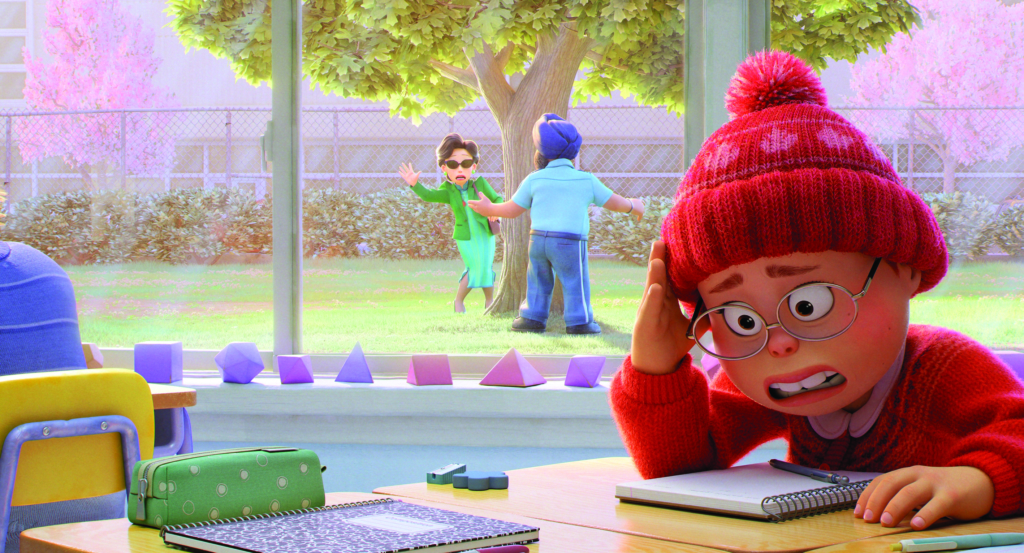
Red panda, red peony, Red Moon Ritual
That night, Mei has delirious dreams about red pandas (which also happen to be symbolically important to her family and the temple they maintain). When she wakes, Mei is hairier, hungrier, bulkier and – as she tells us, because this film isn’t in Smell-O-Vision – stinkier than ever before. Mei has transformed into a giant red panda.
Let’s pause here and peel back the metaphor. When Mei turns into a red panda, the attributes she exhibits reflect how young people (of all genders) often experience their bodies as they go through puberty. Hair sprouts in places where it has never been before. Appetites change. Little bodies grow upwards and outwards on their way to becoming adult-sized bodies. And yes, tweens and teens do start to smell differently![2]See Joshua A Krisch, ‘Why Preteens Smell Bad as Puberty Gets Started’, Fatherly, 8 June 2018, <https://www.fatherly.com/health-science/why-preteens-smell-bad-puberty/>, accessed 23 May 2022.
In the real world, we may not turn into red pandas as we go through puberty, but we sure do transform into very different physical and emotional beings from what we once were.
In the real world, we may not turn into red pandas (or any other non-human creatures) as we go through puberty, but we sure do transform into very different physical and emotional beings from what we once were. Like Mei, we often feel like we have little control over the changes our bodies are making and the intense emotions we are feeling.
Mei’s transformation has a deeply symbolic element: the colour red. Even as she returns to her human form, her hair (previously dark) remains a titian hue. The film loosely connects the symbolism of a teen girl ‘turning red’ with the beginning of her menstruation, although the words ‘period’ and ‘menstruation’ are never spoken in the film. There is, however, an extended comedy bit in which panda Mei rushes to (and then locks herself in) the bathroom and her mum and dad think she’s having her first period; loudly and excitedly, Ming asks whether ‘the red peony’ has ‘bloomed’, and bursts into the bathroom, bringing boxes of maxipads, tampons and painkillers with her.
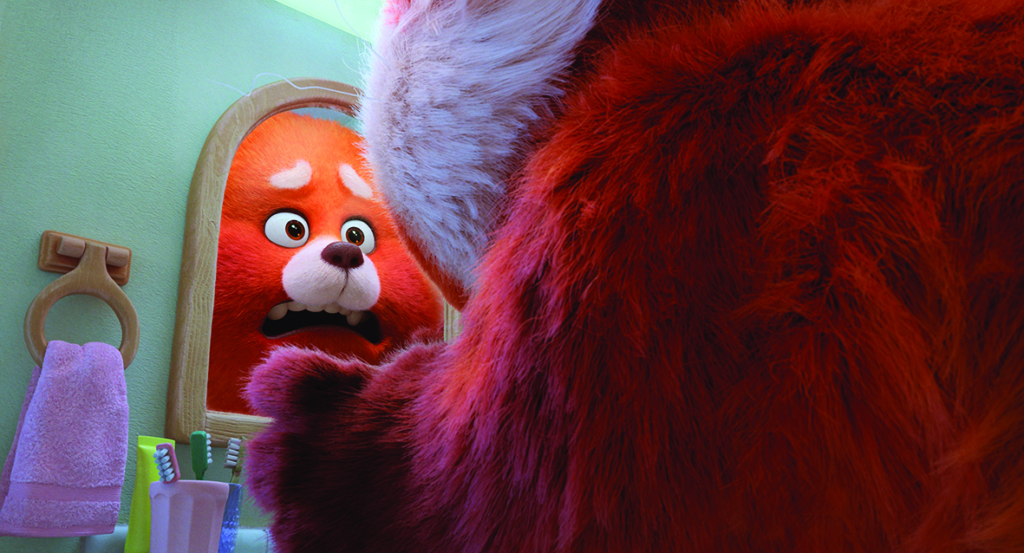
In Turning Red, panda Mei operates as an external representation of adolescent development. The animal form also links Mei to her intergenerational identity. As it turns out, the women in her family have been blessed – or cursed – with the ability to turn into a red panda once they reach puberty (as Mei puts it, it’s an ‘inconvenient genetic thingy’). From now on, Mei will transform into an oversized red beastie every time she experiences a strong emotion (both ‘good’ or ‘bad’, like desire or fun, rage or anger).
‘Pandaness’ started as a protection power. In ancient times, Mei’s venerated ancestor Sun Yee was granted it by the gods to protect her descendants from evil in wartime. Yet Mei’s living female relatives, like Ming and Grandma Wu (Wai Ching Ho), prefer to subdue their inner animal, feeling that the modern world has no place for their inner wildness.
The ‘solution’, according to Mei’s relatives, is to go through a ritual at the time of the red moon, which happens only three times a year and is due in a month (a red moon is also known as a ‘blood moon’ – more period allusions, anyone?). The ritual involves a sacred song that transports the women to the celestial plane, where they can ‘trap’ their panda spirit in an object like the talisman Ming wears around her neck.
• What are some of the verbal/visual allusions used to parallel Mei becoming a red panda with that of a teenager going through puberty?
• Do you think Mei should obey her female relatives and go through with the Red Moon Ritual? Why or
why not?
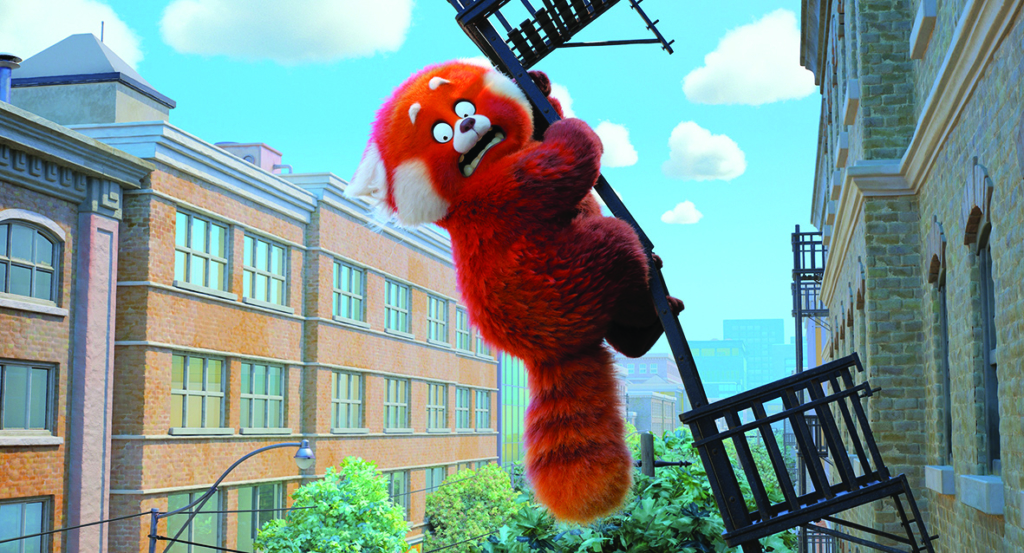
An intergenerational battle of wills
The tensions that often exist between mothers and daughters run right through Turning Red.The red panda is, after all, Mei’s ancient matrilineal inheritance. Mei and Ming form opposing opinions on how to manage this transformation, but they also battle along other, more familiar lines regarding Mei’s desire to be independent and make her own decisions – such as attending a concert by her favourite boy band, 4*Town.
Ming responds to her daughter’s growing sense of autonomy by tightening the grip she has over her daughter’s life. To Mei’s growing horror, Ming reads her secret notebook, follows her to school, forbids her from going to the concert and insists she go through with the Red Moon Ritual. She also makes it clear that she disapproves of Mei’s close friends, Miriam (Ava Morse), Priya (Maitreyi Ramakrishnan) and Abby (Hyein Park).
• Mei says that being thirteen means she can do ‘a spontaneous cartwheel if I feel so moved!’ Yet she also says she wants to be a ‘perfect little Mei-Mei’ for her parents. How is Mei’s inner conflict in simultaneously trying to be an individual and a dutiful daughter illustrated in the film?
• Why does Ming disapprove of Miriam, Priya and Abby? What does this reveal about Ming’s attitudes to the wider world?
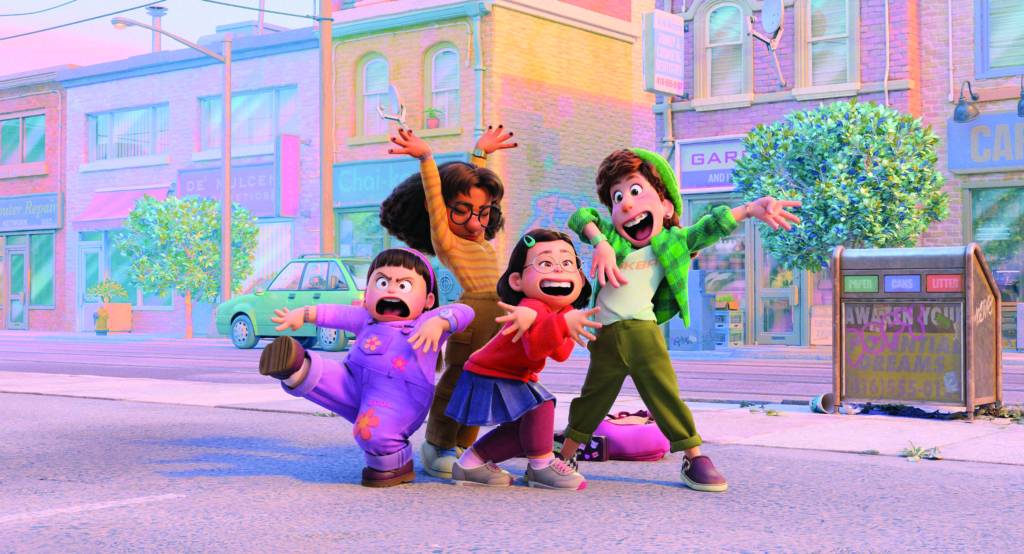
Friendship power circles
Turning Red offers us one major difference between Ming and Mei: Mei has made friends who don’t share her Chinese heritage. Miriam, Priya and Abby come from a diverse set of backgrounds: Miriam is into skater culture, and is the one who ends up offering Mei suitable sanitary items for her period; Priya loves vampire novels, and is also the brains behind the group’s ‘Operation 4*Town Shakedown’ scheme; and quick-tempered, Korean-speaking Abby is a chaos agent who nonetheless loves her friends and will go into battle to defend them.
Turning Red offers us one major difference between Ming and Mei: Mei has made friends who don’t share her Chinese heritage… It is their combined influence that helps turn Mei’s initial feelings of shame and embarrassment about her new body shape into one of empowerment.
It is their combined influence that helps turn Mei’s initial feelings of shame and embarrassment about her new body shape into one of empowerment. Initially, both at home and at school, Mei hides in the bathroom whenever she transforms into a red panda. However, her three best friends encourage her to learn how to harness her power, and how to transform into and out of her new form at will. Mei discovers that by thinking about her friends at moments of high stress, she is able to calm herself down – and transform from panda Mei back into regular human Mei.
With the help of her three besties, Mei reacts to her mum’s increasing power trip by developing an approach of rebelliousness and secrecy. The four girls plot to buy 4*Town concert tickets with money they earn from a side hustle monetising panda Mei. For cold, hard cash – and with immense enjoyment – they hire her out to attend events and parties, and create and sell an impressive line of merchandise.
• The four girls have different cultural backgrounds. Can you tease out what some of their own cultural rituals might be?
• Abby, Miriam and Priya are delighted by Mei’s transformation. What are some of the ways they celebrate Mei’s growing-up body?
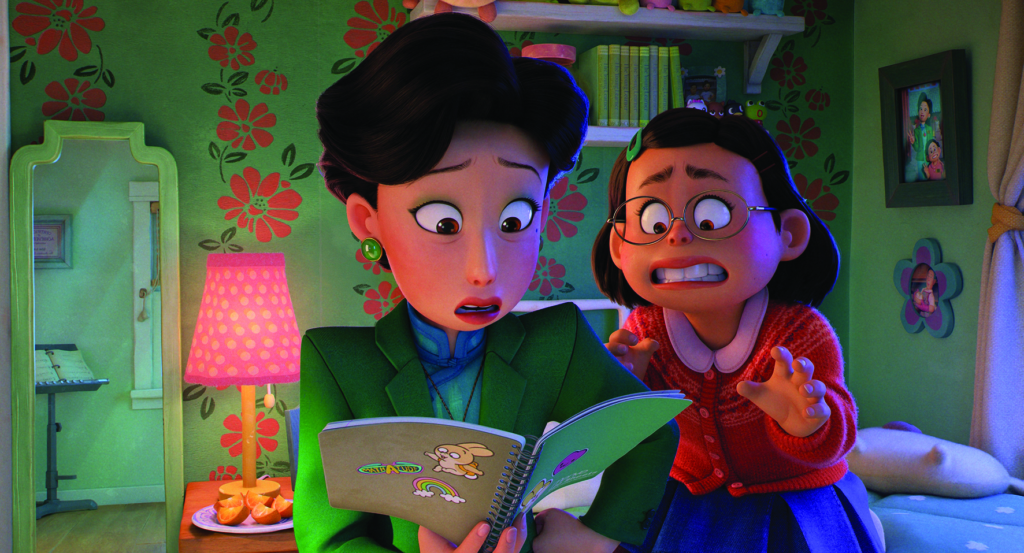
When the Big Bad is your mum
Mei’s refusal to follow her mum’s directives infuriates Ming. Her fury grows, before exploding in a violent and symbolic way. When Mei leaves the Red Moon Ritual to go to the 4*Town concert, she accidentally shatters the talisman containing her mum’s panda spirit. If Mei thought her panda was huge, it pales in comparison to Ming’s version, which is of Godzilla-like proportions. Mei (alternating between panda and human form) and panda Ming battle it out at the concert, with Mei eventually knocking her mother out.
It takes the combined powers of all the aunties and Grandma Wu (plus 4*town and the audience singing the ritual song) to transport Ming to the celestial plane in order to heal her. There, Mei is able to reconnect with her mum and learn something about her at the same time.
It turns out that Ming decided to go through her own Red Moon Ritual because, as panda Ming, she had physically fought – and scarred – her own mum. The potential for violence in her kaiju-sized panda form both scared Ming and filled her with guilt; she believed that nothing she did would ever be good enough for her mother. Mei gently talks her around by sharing some of her own experience as a daughter, saying, ‘I know it feels that way – like, all the time. But it isn’t true.’ This simple statement has a healing effect on Ming.
Ming and the other women choose to re-trap their panda forms in talismans. Mei, however, decides not to. She is going to follow a different path: she will live with her pandaness by learning to regulate her emotions – this time, with Ming’s full approval and acceptance.
• Was repressing her own panda spirit a wise decision for Ming? (You might like to think about how it affected her relationships with Grandma Wu and Mei.)
• Why do you think Mei is able to turn Ming’s disapproval into acceptance of her Red Panda lifestyle?
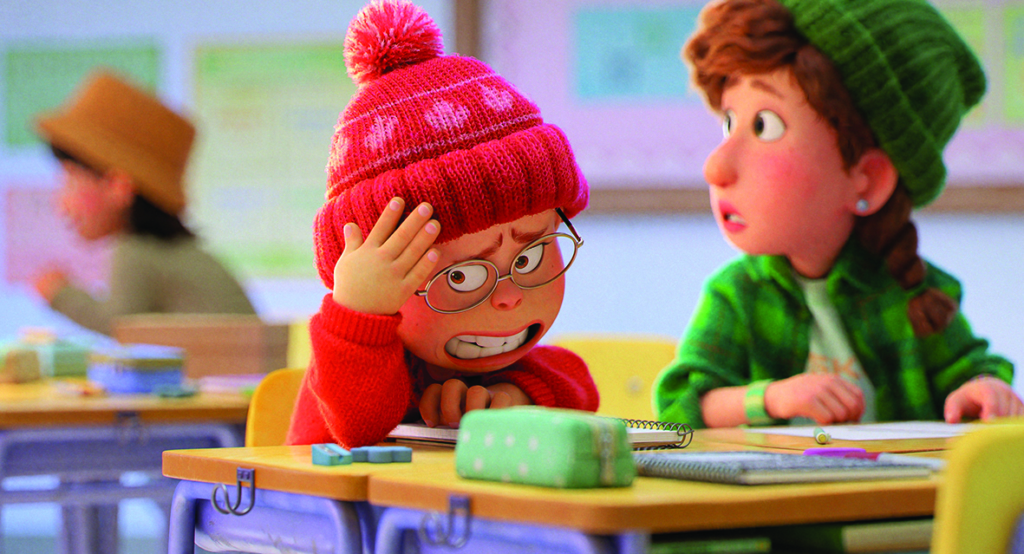
The way of the Red Panda
With all that Mei has learned about her cultural heritage, her body and its unique abilities, her mum’s history and motivations, and the lessons from her peers, she is able to create a future all her own – a happier one, fit for a modern Chinese-Canadian girl. Mei’s decision to not give up her inner red panda still allows her to honour her family’s ways; panda Mei becomes a featured attraction at the family temple. Her choice strengthens her relationship with Ming, too: now that Ming has let go of some of her own inner guilt, she feels able to release her grip on her daughter’s life. She even relaxes her attitudes towards Abby, Miriam and Priya, inviting Mei’s friends over for dinner. Mei’s journey through puberty may have been traumatic, but it has led her (and her family) to a place of greater love and understanding.
The final words really belong to Mei: ‘We’ve all got an inner beast. We’ve all got a messy, loud, weird part of ourselves hidden away, and a lot of us never let it out. But I did. How ’bout you?’
Endnotes
| 1 | Domee Shi, quoted in Bill Desowitz, ‘Turning Red Is Pixar’s Next Big Thing: How Director Domee Shi Made an “Asian Tween Fever Dream”’, IndieWire, 7 February 2022, <https://www.indiewire.com/2022/02/turning-red-domee-shi-pixar-1234696033/>, accessed 23 May 2022. |
|---|---|
| 2 | See Joshua A Krisch, ‘Why Preteens Smell Bad as Puberty Gets Started’, Fatherly, 8 June 2018, <https://www.fatherly.com/health-science/why-preteens-smell-bad-puberty/>, accessed 23 May 2022. |
